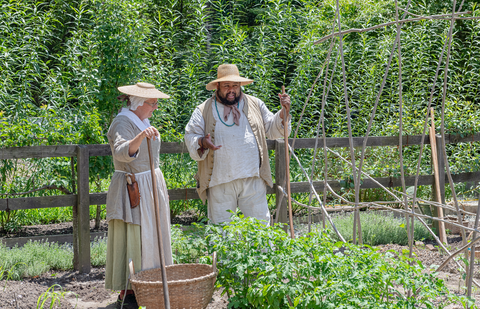Sankofa Heritage Garden : Michael Twitty has made a career out of highlighting the connections between food, history, religion, and culture. The culinary historian, author, and blogger behind Afroculinaria explores the enduring food legacy of the African Diaspora, tracing the roots of today’s cuisines and cultures to emphasize the outsized influence of African traditions and knowledge.
One of his latest projects, though, goes deeper than food on the table, quite literally: Twitty has partnered with Colonial Williamsburg to help tell the history of Black food during Colonial America through a replica of the kind of garden plots enslaved people of the era would have kept.
“One of the things I want to do is to try to bring to life the landscapes of the invisible, the landscapes of the erased and forgotten,” Twitty told House Beautiful during a recent visit to the living history museum as part of its Craft & Forge program, where he gave a tour of the Sankofa Heritage Garden.
“We’re talking about a space that was 52% Black,” Twitty notes of Williamsburg in its 18th-century heyday. The Sankofa Garden endeavors to present more of the history of that oft-overlooked half of the town’s population, providing a living, breathing juxtaposition to the “gentleman’s garden” it sits next to.
The project is part of a larger effort (one that’s gradually happening across many historical institutions) to reframe historic museums through a broader lens, one that encompasses all the residents who would have lived in a historic space—and contends with the darker history of what went on there, something many historic homes and museums have often swept under the proverbial rug.
Derived from a Ghanaian term meaning “to go back,” Sankofa celebrates ancestral heritage—and what can be learned from it today. To Twitty, the core of the Sankofa garden is displaying not only the types of crops enslaved people were growing at the time, but paying homage to the immense knowledge enshrined in these crops and how they’re used.
“These gardens were spaces of knowledge,” he explains. In the garden plots they maintained, Twitty points out, enslaved people in Colonial America practiced techniques like companion planting and animal repelling (peppers on the edge of a plot, for example, kept out foragers, while basil deterred mosquitoes) that weren’t widely adopted among white, Western gardeners until far later.

“In Africa, there are different forms of knowledge for different people,” Twitty says. In contrast to Western ideology, which tends to value so-called “intellectual” knowledge over learnings passed down through family or neighbors (which are often dismissed as superstition), in most African traditions, “it’s not hierarchical—everyone has a different knowledge.”
The Sankofa garden makes clear the impact that this knowledge had on plant and food culture in America—a legacy that continues to this day. “So many other things changed irrevocably since then, but the food did not,” Twitty notes, citing the enduring popularity of things like tomatoes, peppers, peanuts, and beans in foods associated with the American South—all elements that trace their roots back to the African continent, and which were nurtured by people of African heritage in the New World. “They brought with them seeds and ideas that would become southern food,” Twitty notes.
Though for the people who would have been working a plot like this, the garden—which would have been tended at night, as daytime was spent toiling for the enslavers—was much more than a food source, Twitty points out. It was a means of preserving a legacy, connecting a community of people who had been brutally displaced, and providing a creative outlet for people who were systemically denied one. “These gardens are not just food,” says Twitty. “They’re a release for the mind.”
The Sankofa Heritage Garden is open for tours at Colonial Williamsburg; click here for more information.


